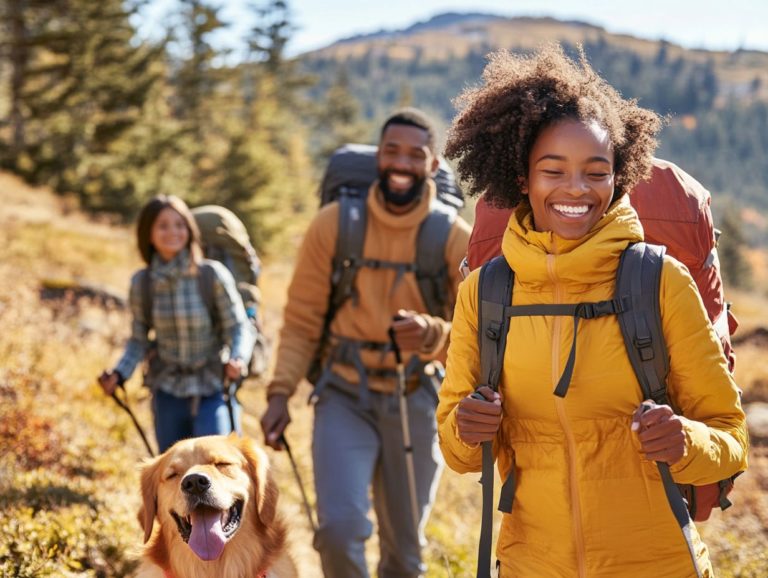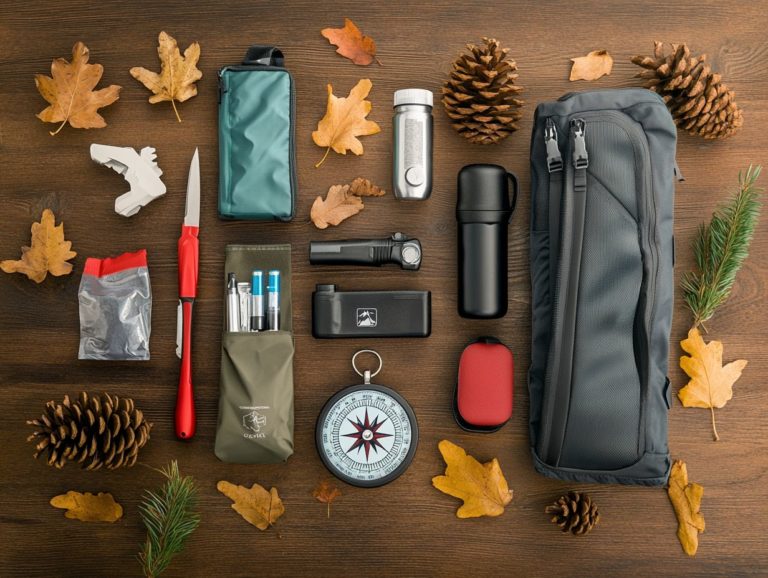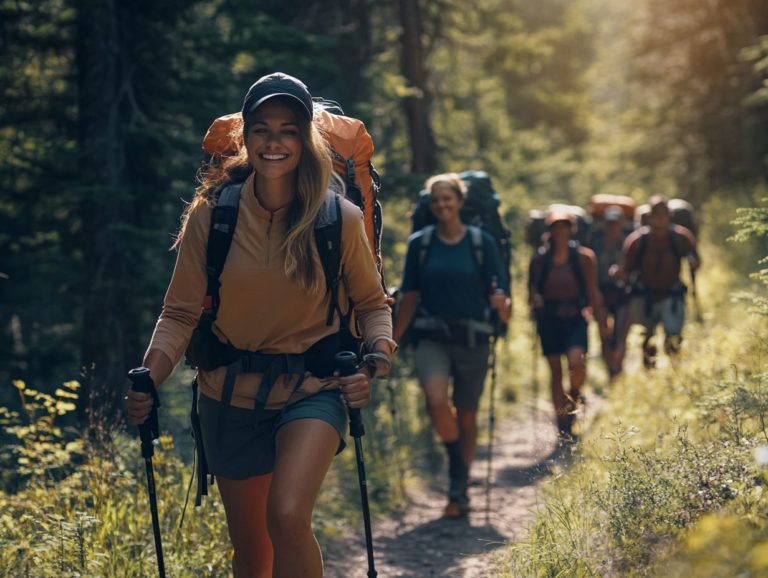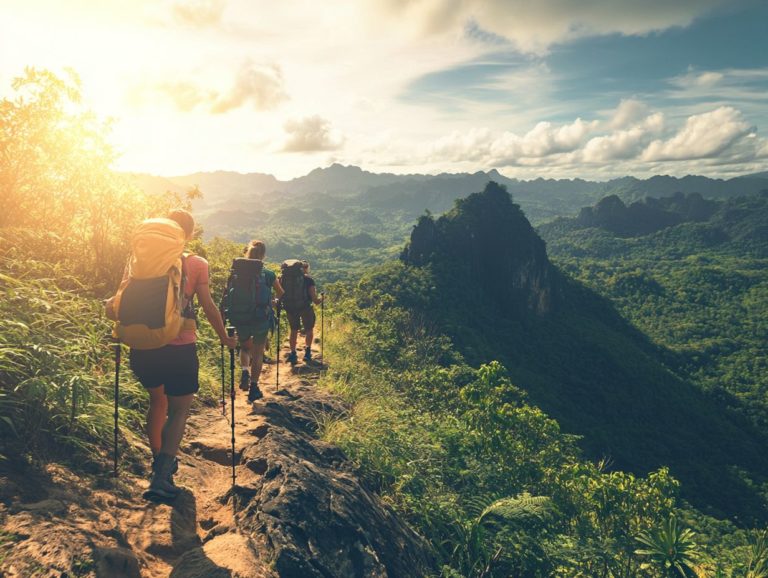Hiking Safety Tips: What You Need to Know
Hiking stands as one of the most rewarding ways to connect with nature. However, it demands careful preparation and knowledge to ensure your experience is both safe and enjoyable.
Get ready to discover the must-have gear that will elevate your hiking experience! This article highlights essential gear and supplies, important trail etiquette, and offers navigation tips to keep you oriented throughout your journey.
You ll also find guidance on handling emergencies, protecting yourself from weather hazards, and maintaining proper hydration and nutrition along the way.
Wildlife safety is addressed as well, helping to ensure your adventure remains worry-free.
Whether you re a seasoned hiker or just starting out, this guide equips you with valuable insights to enhance your outdoor experience.
Contents
- Key Takeaways:
- Preparing for a Hiking Trip
- Staying Safe on the Trail
- Dealing with Emergencies
- Protecting Against the Elements
- Proper Hydration and Nutrition
- Staying Safe in the Wilderness
- Frequently Asked Questions
- Ready for your hike? Don’t forget these essentials!
- How should I prepare for a hike?
- What should I do if I encounter wildlife on a hike?
- What are some safety precautions to take while hiking?
- What should I do in case of an emergency during a hike?
- What are some signs of heat exhaustion and how can I prevent it?
Key Takeaways:

- Always be prepared with essential gear and supplies before embarking on a hiking trip.
- Practice trail etiquette and navigation to ensure safety while on the trail.
- Be knowledgeable about first aid and emergency protocols in case of any emergencies during the hike.
Preparing for a Hiking Trip
Preparing for a hiking trip is essential to ensure you have an enjoyable experience while prioritizing your safety and comfort on the trail. Whether you re venturing into the backcountry or exploring the stunning trails of national parks like the Great Smoky Mountains, grasping the essentials of hiking is crucial.
Planning your hike requires you to select the right trail and assess your fitness level. You should also know exactly what gear to bring along. Familiarizing yourself with hiking safety measures, such as understanding altitude illness when your body struggles to adjust to high elevations, will significantly contribute to the success of your adventure. For more tips, check out this guide on how to enjoy a solo hiking trip safely.
Essential Gear and Supplies
When you set out on a hiking trip, having the right essential gear and supplies can truly transform your experience from enjoyable to challenging. A solid pair of hiking boots provides necessary support and traction, helping you avoid slips and discomfort on uneven terrain.
A well-stocked first aid kit is crucial, offering you peace of mind by ensuring that you can effectively manage minor injuries on the trail. Adequate water and food supplies keep your energy levels up and prevent dehydration, especially during strenuous hikes.
Having an emergency plan in place is crucial for navigating unexpected situations with confidence, ensuring a safer and more comfortable adventure overall.
Staying Safe on the Trail
Safety on the trail is your top priority! It requires careful preparation and attentive awareness of various safety protocols and environmental factors. Familiarizing yourself with how to navigate unfamiliar trails, being ready for changing weather conditions, and staying updated on trail closures can greatly enrich your hiking experience.
By honing your navigation skills whether through a compass or a GPS device you can maintain your course and steer clear of potential dangers in the backcountry.
Understanding trail etiquette and navigation is essential for preserving the natural beauty of hiking trails. It ensures that everyone has a respectful experience in the great outdoors. Embrace these principles to help protect our beautiful trails while enjoying nature.
Sticking to designated paths not only safeguards delicate ecosystems but also minimizes your impact on the native flora and fauna. Adopting the ‘Leave No Trace‘ philosophy means taking actions like packing out what you pack in and avoiding shortcuts that could mar the landscape.
Familiarizing yourself with navigation tools such as maps, compasses, and apps can significantly enhance your hiking experience, making it both safer and more enjoyable. Being courteous to fellow hikers is vital; allowing faster individuals to pass and sharing trail space fosters a sense of community among outdoor enthusiasts.
Dealing with Emergencies
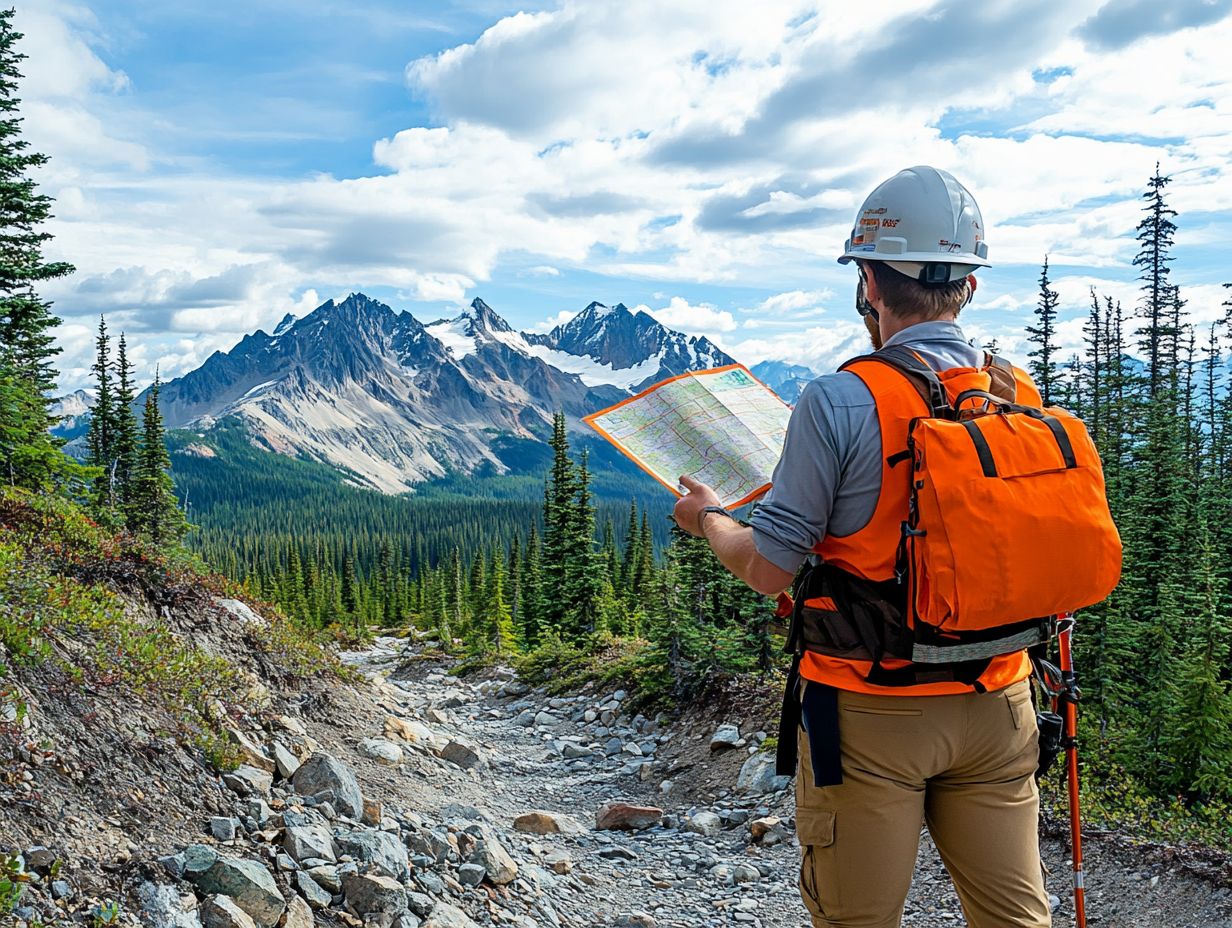
Navigating emergencies while hiking requires preparedness and knowledge. Unforeseen circumstances can arise even on familiar trails.
Establishing a comprehensive emergency plan complete with a well-stocked first aid kit can prove invaluable when faced with injuries or medical issues like feeling sick at high altitudes.
Whether you find yourself in the backcountry or exploring a national park, being equipped to handle emergencies prevents minor setbacks from becoming major problems.
First Aid and Emergency Protocols
A well-stocked first aid kit is an essential companion on any hiking adventure. It equips you with items to address injuries and medical conditions that may arise along the trail.
It s not just about tossing in bandages and antiseptic. A complete first aid kit should also include gauze pads, adhesive tape, tweezers, scissors, and a thermal blanket.
Additionally, having a solid grasp of CPR is crucial it can truly be the difference between life and death in critical situations.
Knowing how to set up an emergency shelter is equally important. Unpredictable weather can strike at any moment, leaving you exposed.
As a hiker, you must also be aware of medical conditions like dangerously low body temperature and dehydration. Spotting symptoms and acting quickly can make all the difference in your safety and enjoyment on the trail.
Protecting Against the Elements
Protecting yourself against the elements is an essential part of hiking. It demands a sharp awareness of weather patterns and environmental hazards.
Being weather-ready means you should consistently check forecasts and prepare for sudden shifts in conditions that could impact your safety.
By understanding potential environmental threats such as thunderstorms and extreme temperatures you can make informed decisions before and during your hike. This approach ensures a more enjoyable and secure outdoor experience.
Weather and Environmental Hazards
As a hiker, you must remain vigilant about various weather and environmental hazards that can threaten your adventures.
Thunderstorms can emerge abruptly particularly in mountainous areas. It s essential to check the weather forecasts before you set out.
Extreme heat poses risks, potentially leading to dehydration and heat-related illnesses if precautions aren t taken.
In terms of wildlife, encounters with mosquitoes may cause discomfort and expose you to potential diseases. More formidable dangers like black bears and mountain lions require a solid understanding of safety protocols.
The presence of rattlesnakes also calls for careful foot placement and heightened awareness of your surroundings.
By carrying sufficient water, applying insect repellent, and familiarizing yourself with wildlife behaviors, you can significantly mitigate these risks. Don’t forget to also bring hiking boots to tackle various terrains effectively.
Proper Hydration and Nutrition
Proper hydration and nutrition are essential for a successful hiking experience. They provide you with the energy and stamina needed to conquer trails of varying difficulty.
Ensure you have sufficient water and food, as dehydration can quickly lead to fatigue and diminish your performance.
Opt for nutritious snacks, like trail mix, energy bars, or fresh fruits. These will help sustain your energy levels and keep you motivated during longer hikes.
Pack your water and snacks today for your next adventure!
Fueling Your Body for the Hike
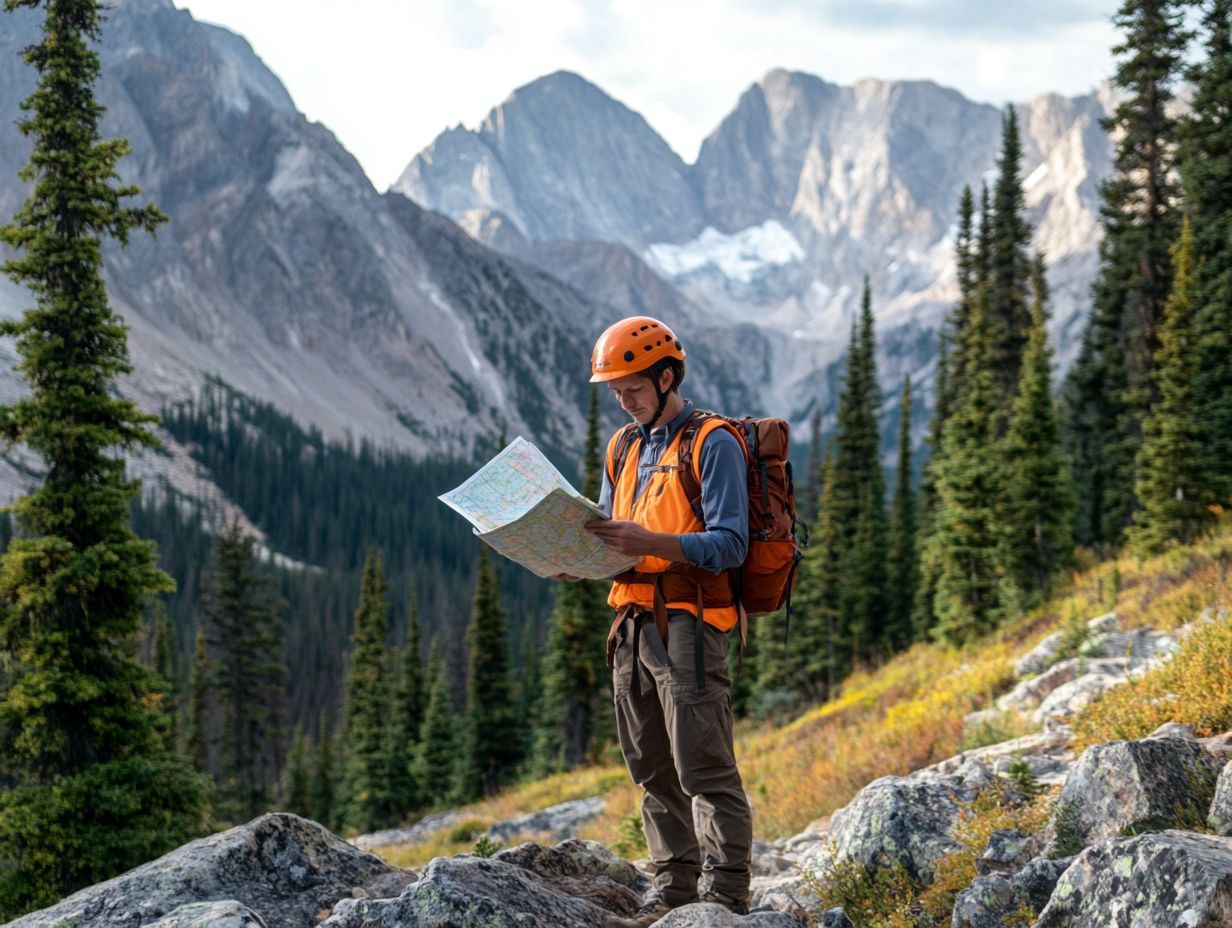
Fueling your body for a hike is crucial. It requires a balance of water and food to sustain your energy.
Staying hydrated is just the beginning. Choosing the right foods can significantly enhance your performance and enjoyment on the trail.
Energy bars are a convenient option, packed with carbohydrates, protein, and essential nutrients for active days. Fresh fruits like bananas and apples provide natural sugars and electrolytes, making them perfect snacks for your hiking adventures.
Preparing meals in advance, such as trail mixes made from nuts, seeds, and dried fruits, allows for easy portability and helps prevent hunger. Including items like energy bars in your nutrition plan enhances your hiking experience.
Staying Safe in the Wilderness
Stay alert! Understanding hiking safety is key to enjoying the wilderness. This includes knowing about hiking safety, wildlife interactions, and proper campsite etiquette.
It’s important to coexist with wildlife, like black bears and mountain lions, to avoid potential confrontations. Practicing good campsite etiquette, such as securely storing food and minimizing campfire impact, helps create a respectful environment for hikers and wildlife alike.
Wildlife Safety and Campsite Etiquette – Know Your Limits
Wildlife safety is essential for any hiker, especially in areas where encounters with animals like black bears and mountain lions are possible. Knowing your limits when exploring these wilderness areas is crucial.
By understanding animal behavior, you can take precautions to ensure your safety and that of local wildlife. One effective strategy is to store your food properly. Planning your hike with necessary precautions further enhances safety.
Using bear-resistant canisters or hanging food bags high in trees can deter these creatures from raiding your campsite. Staying aware of your surroundings and maintaining a tidy campsite can drastically reduce the chances of attracting wildlife.
Properly disposing of waste and avoiding food scraps are simple yet vital practices that contribute to a safer outdoor experience.
Frequently Asked Questions
Ready for your hike? Don’t forget these essentials!
Some essential items to bring on a hike include:
- Map
- Compass
- First aid kit
- Plenty of water
- Snacks
- Appropriate clothing
- Proper footwear
- A way to communicate in case of emergency
How should I prepare for a hike?
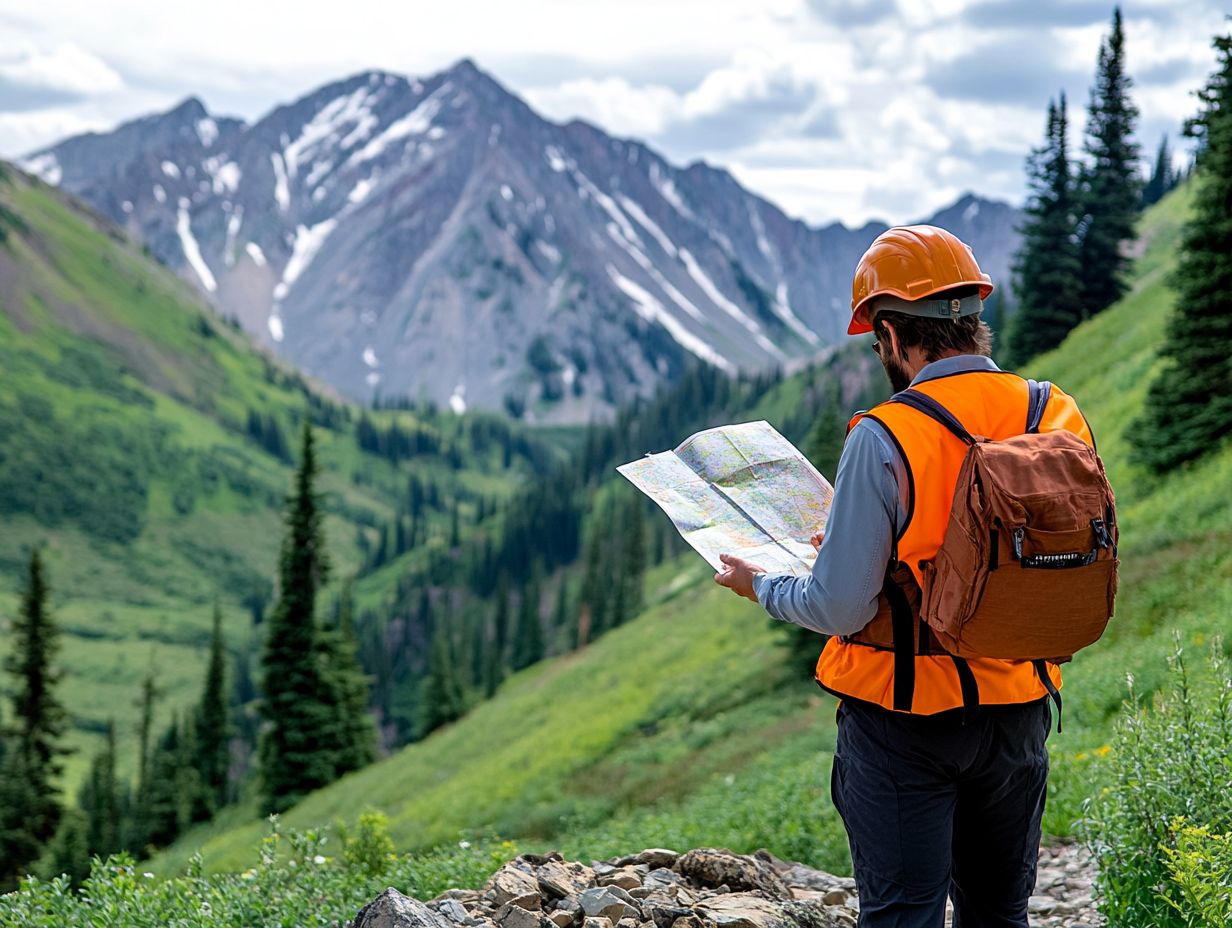
To prepare for a hike, research the trail beforehand, check the weather, inform someone of your plans, and bring necessary supplies. Acclimating yourself to trail conditions is also advisable. Knowing your limits and ensuring you are physically and mentally prepared is key.
What should I do if I encounter wildlife on a hike?
If you encounter wildlife, stay calm and slowly back away. Do not approach or feed the animals. If necessary, make noise or use bear spray to deter them. Always respect the animals and their habitat and remember to stay on the trail.
What are some safety precautions to take while hiking?
Some safety precautions to consider include:
- Staying on marked trails
- Checking weather conditions before and during the hike
- Staying hydrated
- Being aware of your surroundings
- Having a flashlight
- Using hiking poles
It’s also important to hike with a buddy, let someone know your plans, and be prepared to perform CPR if needed.
Plan your next adventure today!
What should I do in case of an emergency during a hike?
Stay calm during a hiking emergency. Assess the situation carefully.
Use your communication device to call for help or signal for assistance.
Always know your limits and be prepared for unexpected scenarios.
If you’re lost, stay put and wait for rescue teams.
What are some signs of heat exhaustion and how can I prevent it?
Stay alert! Recognize signs like dizziness, nausea, and headache early.
To prevent heat exhaustion, stay hydrated and take frequent breaks in the shade.
Wear light and breathable clothing.
Get used to the heat before starting tough hikes.
Avoid hiking during peak sun hours. Listen to your body and rest when needed.

